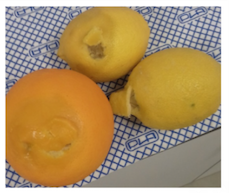The EC published the Commission Implementing Regulation (EU) 2018/1865 of November 28, 2018 on the non-renewal of the approval of the substance propiconazole, in accordance with Regulation (EC) No 1107/2009 of the European Parliament and of the Council, concerning the marketing of phytosanitary products and amending Commission Implementing Regulation (EU) No.540 / 2011 (OJ L No. 304 of 29.11.2018). In accordance with the aforementioned regulation, and as confirmed by the Ministry of Agriculture on February 7, 2019, propiconazole could only be marketed until July 31, 2019, and it could only be used until March 19, 2020.

Given the limitations imposed by the EU, the sector seeks effective strategies to combat the Geotrichum candidum fungus. One of the strategies to combat the main post-harvest fungi is the use of synthetic phytosanitary products, which have very specific mechanisms of action, and that attack fungal cells by killing them and, therefore, prevent their growth. Synthetic fungicides act only at the level of a target molecule. This generates a high level of resistance to these fungicides; if the target molecule undergoes a simple modification, the fungicide is no longer effective against the fungus.
On the other hand, there are preservatives and natural products with more generic mechanisms of action that prevent the growth of fungi in a more respectful way. They are also used daily in the conservation of millions of foods worldwide and are very safe to use.
The treatments manufactured and marketed by Sanifruit are designed from preservatives and natural extracts, which exert different modes of action on pathogenic fungi.
The preservatives work against the fungus at various levels: pH alterations, activation of defense mechanisms, inhibition of fungal growth, inhibition of spore germination.
Natural extracts have numerous molecules (essential oils, tannins, saponins, sterols, jasmonates, flavonoids, quinones, alkaloids, isothiocyanates) that also exert an effect at several levels:
- They stimulate defense responses by the fruit and generate a natural protective barrier against infection.
- They modify the pathogen's structure at the cellular level and inhibit its respiration.
- They interfere with the pathogen's cytoplasmic membrane.
- They inhibit its enzymatic activity, the fungus' energy production metabolism and synthesis of nucleic acids.
The combination of both types of compounds and our experience with them over more than 30 years has allowed Sanifruit market alternative treatments that provide very satisfactory results in the control of the fungus Geotrichum candidum. In addition, these treatments don't affect people's health and respect the environment by not generating toxic spills in their use.
Sanifruit's treatments are based on natural extracts, leave no toxic residues, comply with the aforementioned regulations on the use of pesticides or chemical synthesis treatments, and are in line with the market trends that are increasingly focused on health, well-being, and care for the environment. They are an effective and excellent alternative to combat the Geotrichum candidum, as our current clients can attest.
To find out more, visit Sanifruit at Fruit Attraction 2019 in Hall 6, stand D08.
